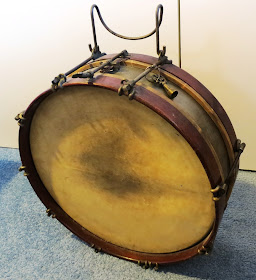John C. Haynes, Company
The John C. Haynes Company was the musical instrument manufacturing division of the Oliver Ditson Company for the entirety of the Haynes Company's existence from 1861 through the end of 1903. So rather than being a truly independent company, John C. Haynes was essentially a brand name within the greater whole of Oliver Ditson & Company, later the Oliver Ditson Company.
John C. Haynes first became employed by Boston music publisher and retailer Oliver Ditson in 1848 and by 1857 had risen to the level of partner with the firm which was then renamed Oliver Ditson & Company. Upon Oliver Ditson's death in 1888, Haynes would become president of the corporation which was then incorporated as the Oliver Ditson Company.
The origin of the business relationship between Ditson and Haynes is well described in an announcement released by the Oliver Ditson Company upon the consolidation of the John C. Haynes Company at the end of 1903:
In 1861 the firm of Oliver Ditson & Co. bought a bankrupt stock of musical instruments. There was no room in the Ditson store to accommodate this large stock, the purchase of which marked a new departure for the firm. A store was therefore rented, and, as it was thought unwise to have two stores in the same city under the name "Oliver Ditson & Co.," the new store designated "John C. Haynes & Co.," Mr. Haynes at that time being Mr. Ditson's only partner. The musical instrument branch has continued ever since as John C. Haynes & Co., but it has always been a department of the Ditson house. We shall remove January 1 , 1904, to our new building, 150 Tremont street, with ample space for all departments under one roof. The reason, therefore, for having a separate name for the musical instrument branch no longer exists, and from that date John C . Haynes & Co. will become Department B of Oliver Ditson Company, with Mr. Charles Bobzin, for many years with Lyon & Healy, of Chicago, as manager.
JOHN C. HAYNES & CO.
----
THE GREAT MUSICAL INSTRUMENT DEPARTMENT OF THE OLIVER DITSON CO., BOSTON, MASS.
----
Much has been printed in many parts of the United States concerning the elegant quarters fitted, and now occupied, by the world's greatest music publishing house, the Oliver Ditson Company, Boston, New York, and Philadelphia, and but little concerning the musical instrument house of John C. Hayes & Co., which, it is well understood, is the musical instrument department of this great publishing house, remarks a writer in the Boston Budget.
A short description of the stores and the business of John C. Haynes & Co. will be of interest. No. 33 Court street, Boston, where the business was established thirty years ago, is still the leading retail musical instrument emporium in America. Business at this old stand has increased steadily, until May, 1889, the firm was obliged to lease the large store No. 694 to 700 Washington street, transferring their wholesale business principally to that store.
A large stock of banjo and guitar music from all publishers, as well as piano music and books, are special features at No. 33 also. Customers will find a competent and obliging corps of salesmen in attendance. John C. Haynes & Co. have recently removed from No. 694 to 700 Washington street to their newly fitted apartments at No. 453 to 463 Washington street. Customers enter at No. 463, taking the elevator to the third floor, which is richly fitted with show cases filled with desirable instruments for musicians.
The next floor is used for storing and shipping. Three large floors in the building No. 453, which are connected with these rooms, are used for laying out dealers' orders, drums, band instrument and repairing departments. Their manufactory, where the "William B. Tilton" and "Haynes, Excelsior" guitars, and "Bay State" guitars, mandolins and banjos are made is located on Stanhope street. Messrs. C. H. Ditson & Co. of New York and Messrs. J. E. Ditson & Co. of Philadelphia draw their musical instrument supplies from John C. Haynes & Co. These houses have largely increased their facilities in this department recently.
At the time of its razing in 1898, the building occupied by John C. Haynes & Company at 33 Court Street (pictured at right) was purported to be the 'Oldest Music House in America' having been previously occupied by Elias Howe whose remaining stock was purchased by Ditson in 1861.
It is a common misconception that any J. C. Haynes drum with a label bearing the address of 33 Court Street dates to the Civil War. While the company was indeed located at this address as far back as the Civil War era, Haynes continued to do business at 33 Court Street decades later even after their newer manufacturing facilities had opened at 453 - 463 Washington Street in the early 1890s.
Instruments labeled with a 694 - 700 Washington Street or 453 - 463 Washington Street address (sometimes in conjunction with the 33 Court Street address) date from 1889 or later. No drums were manufactured under the John C. Haynes & Co. brand name after 1903.
As of January 1st, 1904 John C. Haynes & Co. was absorbed into the Oliver Ditson Company with John C. Haynes remaining as president of the Oliver Ditson Company as he had been since 1888. John C. Haynes died in 1907 after which Charles H. Ditson became president of the Oliver Ditson Company.






























